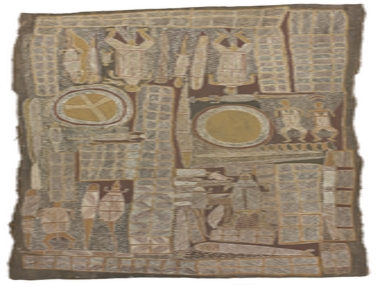THOMSON TIME COMES TO MELBOURNE

Wonggu Mununggurr (with sons, Maama, Mawunpuy and Natjiyalma) Djapu clan, Eastern Arnhem Land, Northern Territory Djapu minytji (Djapu clan design) 1942 natural pigments on eucalyptus bark 189.4 x 105.2 cm The Donald Thomson Collection. The University of
Posted by Jeremy Eccles | 22.06.09
Gallery: Ian Potter Museum of Art - The University of Melbourne
Dates:
02.06.09
: 23.08.09
Thomson Time was discovered Down South when the film, Ten Canoes revealed that in parts of Arnhemland, the period when anthropologist Donald Thomson photographed and recorded his encounters with Yolgnu people in the 1930s and 40s have come to be called Thomson Time Up North.
His encounters weren't simply one way, though. The two-way process which invariably leads to the best results in Black and white relations included the education of young Donald via painting. As Melbourne Museum curator Lindy Allen – responsible for the 60 large barks and as many as 4,500 other artefacts that make up the Thomson Collection for the past 20 years – explains: “The point is not just that Thomson saw the Yolgnu men as artists. It is that they were educating Thomson, drawing him in. They brought him into their world through their art”.
Sadly, only about a third of these great artworks have been cleared for public display with contemporary cultural custodians. You'd have thought such an educative process was something we all could benefit from today. But this limited selection is now on show at the Ian Potter Museum of the University of Melbourne under the title, Ancestral Power and the Aesthetic. Amongst them is work by the fiersome Wonggu Mununggurr, leader of the Djapu clan at Yirrkala, who had already been involved in a deadly clash with Japanese fishermen at Caledon Bay that threatened a military intervention by white Australia. Thomson's efforts calmed the situation heroically, his initial meeting with Wonggu in July 1935 encouraging the warrior to sit down and paint two large barks, which Thomson immediately bought – brushes, pigment and all.
What Thomson came to understand – and document – was the intrinsic importance of minytji, the embodiment of the sacred ancestors through ceremonial designs handed down from generation to generation. For only by getting that just right could the strength and power – the marr – of the Ancestors be experienced. When it is just right, then the viewer receives a flash like “the scintillation of the sun” or “the penetrating flash in the eyes of an angry man”.
A work by another member of the Mununggurr family, Mawunpuy, is a rare depiction of one of the Djan'kawu Sister ancestors in half Yolgnu /half sacred form via her minytji. Similar minytji surrounding the figure is “a reflection of her body on to the ground as she walks along in the sun”.
Thomson also collected at Ramingining and Oenpelli. And journalist Nicolas Rothwell describes the experience of seeing the collection as “compared with the revelation of a roomful of unknown works from the Florentine trecento; early pieces that hold in them clues to the majesty of the bark painting schools of more recent times”. Another precedent was Thomson's commissioning of a set of 10 barks that lay out Yolgnu claims to their land beside the North Western tip of the Gulf of Carpentaria – which were followed by the Bark Petition to Parliament 20 years later.
Incredibly, the vast majority of the artworks on show have never been exhibited or published before, despite Thomson himself lobbying the government for funds to produce a comprehensive book just before his death in 1970.
URL: www.art-museum.unimelb.edu.au
Share this:
»  del.icio.us
»
del.icio.us
»  Digg it
»
Digg it
»  reddit
»
reddit
»  Google
»
Google
»  StumbleUpon
»
StumbleUpon
»  Technorati
»
Technorati
»  Facebook
Facebook
Contact Details
Gallery: Ian Potter Museum of Art - The University of Melbourne
Email: potter-info@unimelb.edu.au
Telephone: +61 3 8344 5148
Address: Swanston Street Parkville Melbourne 3010 Victoria
Gallery: Ian Potter Museum of Art - The University of Melbourne
Email: potter-info@unimelb.edu.au
Telephone: +61 3 8344 5148
Address: Swanston Street Parkville Melbourne 3010 Victoria
Where is the exhibition?
Further Research
Gallery: Ian Potter Museum of Art - The University of Melbourne
Artists: Mawunpuy Mununggurr | Wonggu Mununggurr
News Tags: Arnhemland | bark art | Donald Thomson | Ian Potter Museum of Art | Melbourne Museum
News Categories: Australia
Exhibition Archive
- 10.10.17 | TARNANTHI 2017
- 11.08.17 | Natsiaas 2017
- 20.07.17 | APY ART DOMINATES THE WYNNE
- 17.07.17 | Anangu Artist Wins $100,000 Prize
- 14.07.17 | The End of AAMU
- 11.07.17 | ART ACROSS THE COUNTRY
- 11.07.17 | TARNANTHI IN OCTOBER
- 05.07.17 | TJUNGUṈUTJA - from having come together
- 13.06.17 | Ghost-Nets Straddle the World
- 07.06.17 | Grayson Perry Going Indigenous?
- 05.06.17 | Barks Bigger than Ben Hur
- 27.05.17 | NGA QUINQUENNIAL 2017
- 21.05.17 | Blak Douglas Finds Home at the NGA
- 21.05.17 | BRIAN ROBINSON WINS HAZELHURST WOP
- 18.05.17 | PARRTJIMA 2.0
Advertising

